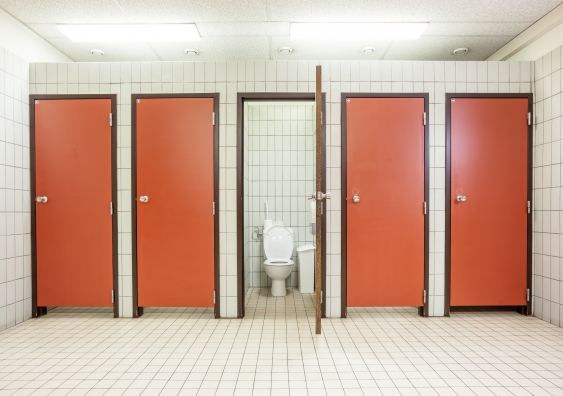At your convenience
Public toilets are making us miserable, so what can we do about it?
Public toilets are making us miserable, so what can we do about it?

In the late 1980s, our friends living on Sydney’s Palm Beach in the old Beacon Tea Rooms had no flushing toilet. One of them, a judge’s son and architect, used a galvanised bucket. The other, a Czech emigre, used the public toilet block across the road.
This toilet block, like so many others, was not responding to its breathtaking location. Instead it was a sturdy brick bunker. There is a term in the Australian vernacular that refers to these structures: “built like a brick outhouse”. I’ve paraphrased slightly.
The public toilet is where we carry out a very private basic human need. These facilities set the tone for public conduct and expectations. They are a built expression of our values.
So what is the preoccupation with the bomb-proofing of this kind of vital public infrastructure? Is it expressing a perception of our fellow citizens and their expected behaviour? How do people respond in these places to the need for privacy, comfort, a place to compose oneself, to refresh and groom?
Warren Buffett said if you want to ensure the success of your brand you need to truly delight your customers. On my daily journeys through the city as an able-bodied, middle-aged male, the toilets that I use are neither delightful nor enchanting. At best they work and are bearable. They make me feel like I’m being begrudgingly accommodated.
Interestingly, public toilets are not unisex, like those we use at home or on aircraft. Does this contribute to making them places for illicit activities, and lend them a seedy feel?
Public toilets are also one of the most incendiary battlegrounds in the transgender community’s ongoing fight for civil rights, as these spaces have been for women, African-Americans and the disabled community. Social attitudes are literally imbricated in these structures, which are slow to change with our zeitgeist.
Even when we finally find one that is open – not an easy task at times – we generally find a space that is hardly the result of a masterclass in excellent design. Thankfully, there are some notable exceptions.
Usually we find ourselves in one of the most economical layouts possible, trimmed down to its absolute bare minimum – and, if lucky, with ventilation and light both working.
Universal toilets introduced at least an element of spaciousness. Thanks to wheelchair users, you no longer need to hold your breath in a claustrophobically small space.
However, there is often no provision for the things that we carry with us when we move through the city. If there is a hook on the back of the door, it’s often broken. Putting a bag on a public toilet floor or a wet sink surround does not appeal. And how much harder it must be to use a public toilet while looking after children!
When and how exactly did we decide that these conveniences have to be so inconvenient?
Singapore Airport shows what can be done. It has large spacious toilets, which are wonderful – they even have multiple hooks. A wheelie case can effortlessly be brought into the cubicle.
These toilets are quiet, clean and smell good. These toilets communicate to me that my needs are understood.
They provide a place where I can feel dignified. They set the tone for public conduct.
Toilets like this say ‘we respect and we appreciate you and we offer you this to make you feel better’. As a result, I conduct myself accordingly and not begrudgingly. I leave delighted and deeply impressed by Singapore’s attitude towards its guests.
Wouldn’t it be nice if that was the feeling we could all have when leaving public toilets?
Christian Tietz is a Senior Lecturer in Industrial Design at UNSW Built Environment. This is an edited version of an article originally published on The Conversation.